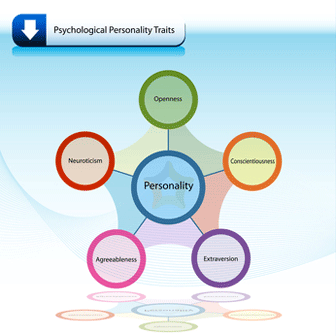Big 5 Personality Tests Evaluate Your Five Basic Factors
The big 5 personality tests measure your intensity to deal with people, change, and environment and handle work and depression situations. Extreme levels may qualify or disqualify you for some jobs, but moderate scoring is considered suitable for most of the careers. It is somewhat different from the famous Myers Briggs Types Model, and some even think it a leap upon the types theory. Whatever they may claim, they are not poised to predict how you shall behave in future.
Here you shall read how and why big 5 personality tests came into being?
What are five big factors?
How psychologists calculate them?
And much more...
A New Light on Big 5 Personality Types by Brian Little on Video
Empirical History of Big 5 Personality Tests
It all started when Allport challenged psychologists, in 1930s, to organize different variations of human personality in the least number of lexical units. Some of his contemporaries believed that natural languages have such words which can be used to describe all variations in the human psychology. This ‘lexical hypothesis’ led them to generate some lists which mainly focused upon five big traits of the human personality.
However, the current structure of the big 5 personality tests didn’t appear until two different teams of psychologists administered separate inventories to thousands of the people. One team was led by Paul Costa and Robert McCare and the other by Warren Norman and Lewis Goldberg. The both groups analyzed their deduced data and concluded in 1970 that human personality can be described with five big factors.
The five-factor model gave birth to the five factor theory which resulted in some big 5 personality tests. Their exponents rightfully claim that this model does not root in theory but experiment. Lately, many testing companies and nations are shifting towards this test. In words of Oliver P. John and others:
"The comprehensive analyses in Dutch have provided so far the strongest cross-language evidence for the Big 5. Results from a study of English-German bilinguals indicate that the Big 5 form internally consistent and relatively independent dimensions in German as well.... Finally, factor analyses of translations of Norman's...20 scales have replicated the Big 5 in Japanese...." (“European Journal of Personality”)
What is 5 Factor Model of Personality?
The empirical data proves that the subjected individuals agree or disagree to deal with people, change, and environment aggressively. When they work, they are either focused or unfocused. And when they are depressed they either recover fast or take a lot of time to be normal. These five behavioral dimensions are described in the following ‘lexical units’.
Agreeableness or Accommodation (A)
This factor determines your way to deal with the people. A higher degree in this element presumes that you are agreeable, tolerant and courteous. However, a lower degree means that you are disagreeable, aggressive and dominant. Higher levels are termed as adapters and lower as challengers. However, when you score in between, you are considered a negotiator.
Openness To Change (O)
Do you welcome sudden changes or resist them?
A higher scoring suggests that you feel easy with suddenly changing situations. You welcome new ideas. You are original, creative and curious. However, a lower degree proves that you resist changes and favor status quo. You are considered traditional, systematic and static. However, a moderate scoring proposes that you welcome changes at time and can resist them when they are not required.
Extroversion (E)
This factor deals with your way to behave in your environment. When you score higher in this area, you are considered extrovert, assertive and talkative. However, a lower scoring qualifies to be an introvert, down to earth and quiet. And moderate scoring declares you as an ambivalent.
Conscientiousness or Consolidation (C)
This factor determines your style to handle your work situations. You are considered well focused, organized and reliable to complete your work when you score higher. However, you are deemed flexible, disorganized and unreliable in your projects when you score low. A moderate scoring suggests that you are neither workaholic nor lazy. You are quite balanced finisher of the project.
Neuroticism or Negative Emotionality (N)
This factor highlights your way to handle depression. A high degree suggests that you need a lot of stability when you face negative emotionality or depression. You take more time than others to recover from a depression shock. In extreme cases, you are considered in need of psychotherapy to overcome your negative emotions. You are often nervous, reactive and pessimist.
A lower ranking suggests that you have healthy nerves and take less time to recover from depression situations. You are often calm and stable. You think positively and try to find out the best out of the worst.
How Big 5 Personality Tests Determine Your Degrees?
The big 5 personality tests are considered better than Myers Briggs Tests, Temperament Sorter and DISC Tests for some proclaimed advantages. They neither focus upon your types nor temperaments. They try to measure your characteristics to handle the above-given situations. The intensity of the five factors are measured in the following ways:
Do You Agree?
This kind of big 5 personality tests offer certain statements. You are required to select any of the following options for each of the given situation:
1- Strongly Disagree, or
2- Disagree, or
3- Neither Agree Nor Disagree, or
4- Agree, or
5- Strongly Agree
Is it Correct?
This kind of big 5 personality tests offer you a variety of statements. You are required to read each of them and tell the tester which statement is accurate. You have the following options to select one:
1- Very Accurate, or
2- Accurate, or
3- Neither Accurate Nor Inaccurate, or
4- Inaccurate, or
5- Very Inaccurate
Scoring Though the above gives parameters are sufficient to suggest your intensities with different factors. However, some psychologists go a step forward and try to calculate your options in numbers. When you score 55 or higher in such big 5 personality tests, you are considered having strong dimension in the given factor. However, when you score 45 or less, you are deemed opposite to the same consideration. When you score between 45 and 55, it is considered standard deviation of the big 5 personality tests.
Practice with Free Personality Tests
Share Your Thoughts!
We find value in differences between learning, interpreting and overall opinions. Please share your thoughts freely about this topic, but always remain respectful. You can preview and edit on the next page before your submission is sent in. You will also be informed about this site's privacy policies. Thank you for your contribution.
What Other Visitors Have Expressed
Click below to see contributions from other visitors to this page...
Myers-Briggs Fan Fascinated! Not rated yet
I find this five-factor model fascinating. This is my first time to hear of it, and I'm a big fan of the Myers-Briggs Type Indicator (and "friends") theories. …
Recent Articles
-
What type of test did I take
Apr 04, 22 04:09 AM
I was given a psychological test years ago, but wasn’t told what it was for. The rating used a bell curve and my score fell in the above average not yet -
ﹰﹰﹰﹰﹰﹰﹰGOOD
Aug 13, 21 03:20 PM
Since the enneagram test helps people to understand their strength and weaknessess. And helps them remove their weaknesses then the test is good -
Knowing the inner me
Aug 13, 21 03:17 PM
Sometimes I ask myself that is this my behaviour or not? Because I am really shy and I lack confidence, I find it hard to socialize with other people.I

